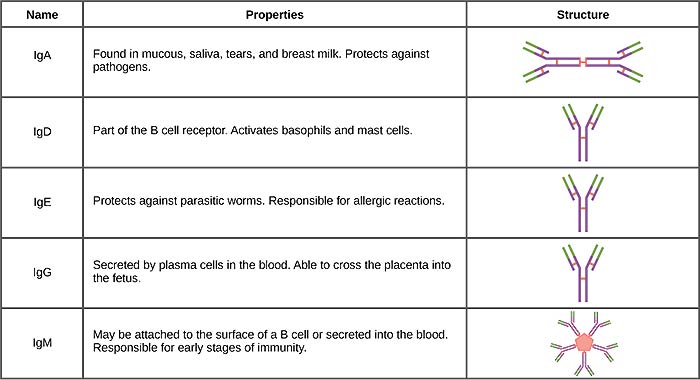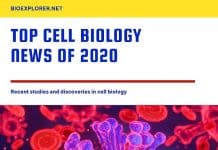
Table of Contents
What Are Antibodies?
The immune system of the body mediates disease-fighting mechanisms using two different types of mediators. There are broadly two types of cells that are involved in the immune reaction – T cells and B cells.
T cells are lymphocytes that bear T cell receptors on their surface and are part of the cell-mediated immune response.
B cells are lymphocytes that produce antibodies upon encountering an antigen or disease-causing pathogen and form the humoral immune response.
Antibodies, also known as Immunoglobulins, are glycoproteins produced by the B lymphocytes upon encountering a pathogenic substance. The antigen produces and displays specific molecules on its cell surface that the antibody recognizes. These Y-shaped proteins then bind to these molecules, destroying and eliminating the pathogen from the body.
Check out the differences between antigen and antibody in detail here.
How Are Antibodies Produced?
When a foreign substance such as a toxin or a pathogen enters the body, circulating B cells recognize certain cell-surface antigenic molecules and bind to them. This process causes the B cells to divide rapidly and form a group of identical mature B cells called a clone.
These mature B cells are called Plasma cells which then secrete millions of antibodies into the bloodstream, thus activating the humoral immune response. As these antibodies circulate through the body, they encounter and recognize specific antigens, aiding in their elimination.
![]()
General Structure of Antibodies

Although there are different classes of antibodies, that is discussed further on in the article, the general structure of all antibodies is the same.
- They are fundamentally heavy globular proteins found in the plasma. The antibody molecule comprises four polypeptide chains – two heavy chains and two light chains.
- Each heavy chain comprises large polypeptides of around 50,000 Da. There are five types of heavy chains – Alpha, Delta, Epsilon, Gamma, and Mu. Each light chain is made up of polypeptides of around 20,000 Da.
- There are two types of light chains – Lambda and Kappa. The heavy and light chains are held together by disulfide bonds, giving the structure of the antibody molecule a Y shape.
- The portion of the heavy and light chains that contact the antigen is called the variable region. It consists of 100-110 amino acids that differ in each antibody molecule depending on the antigen encountered.
Due to this variability, this region is known as the variable region. The other portion of the heavy and light chains that define their subtypes is known as the constant region, and the amino acid content of this region remains constant for each subtype of the antibody molecule.
![]()
Types of Antibodies in Blood
Five antibody or immunoglobulins classes are categorized by their constant region differences. These are IgG, IgA, IgM, IgE, and IgD. They differ in prevalence, function, and constant regions.

IgG

Properties:
- IgG is the most predominant antibody found in the body and constitutes 80% of the total antibody content in the serum.
- It is the only antibody that can cross the placental membrane and provide immunity to the fetus. There are four sub-classes of the IgG molecule: IgG1, IgG2, IgG3, and IgG4.
- Among these, IgG 3 and IgG 4 possess the ability to cross the placenta. IgG1 is the most common antibody subclass among the four.
Structure:
- The heavy chains of the IgG antibody are of the subclass Gamma, with two antigen binding sites. It is a monomer with a molecular weight of approximately 150,000 Da.
Functions:
- It provides immunity to the developing fetus.
- Activates the complement pathway of the immune response.
- Mediates a process known as opsonization which refers to antibodies coating a pathogenic cell to lure the phagocyte toward the antigenic surface of the pathogen.
- Facilitates the process of phagocytosis.
- Neutralization of toxins and pathogens.
- Since it is widely found circulating in the blood, it offers protection against pathogens in the blood and tissues.
![]()
IgA
Properties:
- IgA is found in the mucous membranes of the gastrointestinal and respiratory tracts. It contains mucus secretions, saliva, tears, and the colostrum.
- It constitutes 13% of the total antibody content found in the serum. There are two subclasses of the IgA antibody – IgA1 and IgA2.
- The IgA1 antibody, also called secretory immunoglobulin or sIgA, is most commonly found in secretions in high quantities.
Structure:
- The heavy chains of the IgA antibody are of the Alpha subclass, with four antigen binding sites.
- The molecular weight of IgA is around 385,000 Da. IgA exists in both monomeric and dimeric forms.
Functions:
- IgA is found in the secretions and provides the first line of defense against the uptake of microbes and antigens into the body.
- It limits inflammation.
- Participates in the immune response by activating the complement pathway.
- Provides immunity to the fetus and the newborn infant.
![]()
IgM

Properties:
- IgM is the largest antibody found in the body and is the first produced after an antigen enters the body.
- It is found in the blood and the lymph fluid. It constitutes 6% of the total antibody content of the serum.
Structure:
- The heavy chains of the IgM antibody are of the Mu subclass, and it has ten antigen-binding sites.
- The molecular weight of IgM is around 900,000 Da. IgM exists in the pentameric form and is the largest of all the antibodies.
Functions:
- IgM is the antibody found on the surface of the B-cell that helps in antigenic recognition.
- Activation of the complement pathway of the immune response.
- It is involved in opsonization and agglutination.
- Facilitates efficient immune system activation due to the more significant number of antigenic sites on its surface.
- The ABO system of blood grouping consists of IgM antibodies specific to the ABO antigens expressed on the surface of the RBCs.
![]()
IgE

Properties:
- IgE antibody, also known as the reaginic antibody, is involved in hypersensitivity reactions or allergic responses.
- It is found in the linings of the respiratory and intestinal tracts.
- It is the least abundant antibody, constituting about 0. 002% of the antibody content in serum.
- The antigenic site binds to mast cells or basophils that are known to be involved in hypersensitivity reactions.
Structure:
- The heavy chains of the IgE antibody are of the subclass Epsilon with two antigenic binding sites.
- It exists in the monomeric form and has a molecular weight of about 200,000 Da.
Function:
- Immune protection against pathogens is invading through the gastrointestinal or respiratory barriers.
- It is vital in Type 1 hypersensitivity or allergic responses.
![]()
IgD
Properties:
- IgD antibody makes up less than 1% of the total antibody content of serum.
- It is usually co-expressed on the surface of B cells with IgM.
- Its specific function is still unknown. However, it is thought to be involved in B cell activation.
Structure:
- The heavy chains of the IgD antibody comprise the subclass Delta, with two antigen binding sites.
- It is found in the body as a monomer and has a molecular weight of around 180,000 Da.
- It is present on the surface of the B cell and acts as a receptor.
Function:
- The known function of the IgD antibody is to act as a receptor on the surface of the B cell and participate in B cell activation and differentiation.
![]()
Immunoglobulins are an indispensable asset to the immune system and are now widely used in treatment strategies. Antibodies derived from a clone of cells originating from the same parent cell are developed and used to treat diseases.
These antibodies are called monoclonal antibodies and can be primed with the surface antigen present on the target cell for it to recognize and eliminate it. They are of particular importance in cancer treatment.
Trastuzumab is an example of a monoclonal antibody used in the treatment regime of breast cancer.
Antibody treatment and immune therapy are also being used in the treatment of many other widespread diseases such as diabetes.
![]()

















